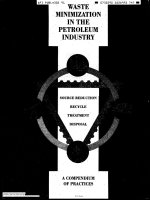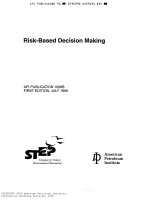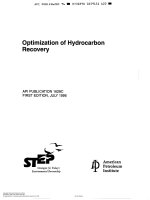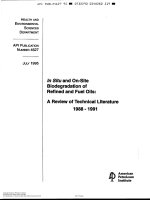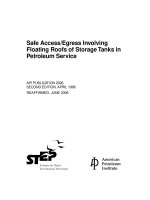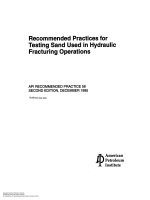Api publ 1161 2000 scan (american petroleum institute)
Bạn đang xem bản rút gọn của tài liệu. Xem và tải ngay bản đầy đủ của tài liệu tại đây (3.72 MB, 106 trang )
Guidance Document for the
Qualification of Liquid Pipeline
Personnel
API PUBL 1161
FIRST EDITION, AUGUST 2000
American
Petroleum
Institute
Helping You
Get The Job
Done Right?
COPYRIGHT American Petroleum Institute
Licensed by Information Handling Services
COPYRIGHT American Petroleum Institute
Licensed by Information Handling Services
Guidance Document for the
Qualification of Liquid Pipeline
Personnel
Pipeline Segment
API PUBL 1161
FIRST EDITION, AUGUST 2000
American
Petroleum
Institute
Helping You
Get The Job
Done Right?
COPYRIGHT American Petroleum Institute
Licensed by Information Handling Services
SPECIAL NOTES
This API Guidance Document for the Qualification of Pipeline Personnel was developed
by the API’s subcommittee on Training to help pipeline operators comply with the Research
and Special Program Administration’s (RSPA) Final Rule on Pipeline Safety: Qualification
for Pipeline Personnel.
Special acknowledgementis given to the Consortium On Operator Qualification (COOQ),
a group of liquid pipeline representatives, which developed several appendices within this
publication, including Example Operator Qualification Premises and Definitions, as well as
the Example Covered Task Lists. The Consortium on Operator Qualification’s efforts and
collaboration with the API Subcommittee on Training was instrumental to the development
of this publication.
All rights reserved. No part of this work may be reproduced, stored in a retrieval system, or
transmitted by any means, electronic, mechanical, photocopying, recording, or otherwise,
without prior written permission from the publisher. Contact the Publisher;
API Publishing Services, 1220 L Street, N. W , Washington, D. C. 20005.
Copyright O 2000 American Petroleum Institute
COPYRIGHT American Petroleum Institute
Licensed by Information Handling Services
FOREWORD
API publications may be used by anyone desiring to do so. Every effort has been made by
the Institute to assure the accuracy and reliability of the data contained in them; however, the
Institute makes no representation, warranty, or guarantee in connection with this publication
and hereby expressly disclaims any liability or responsibility for loss or damage resulting
from its use or for the violation of any federal, state, or municipal regulation with which this
publication may conflict.
Suggested revisions are invited and should be submitted to the general manager of the
Pipeline Segment, American Petroleum Institute, 1220 L Street, N.W., Washington, D.C.
20005.
COPYRIGHT American Petroleum Institute
Licensed by Information Handling Services
COPYRIGHT American Petroleum Institute
Licensed by Information Handling Services
API Guidance Document for the Qualification of Liquid Pipeline Personnel
TABLE OF CONTENTS
Section 3
seetion 4
Background ....................................................................................................................
Regulatory Deadlines .....................................................................................................
Affected Personnel .........................................................................................................
Written Program .............................................................................................................
4.1 Introduction ..............................................................................................................
4.2 Seven Required Elements ........................................................................................
Suggested Program........................................................................................................
....................................
~
5.1 Format .....................................................................................................................
5.2 Process for Developing the Written Program Content ...............................................
5.3 Premises and Definitions..........................................................................................
5.4 Task Identification and Analysis ................................................................................
5.5 Identification of Covered Tasks Using the Four-Part Test ..........................................
..............................
5.6 Evaluation ................................................................................................................
5.7 Communicating Changes in Covered Task Procedures ..........................................
5.8 Non-Qualified Individuals........................................................................................
5.9 Contractor Personnel .............................................................................................
5.10 Record Keeping .....................................................................................................
Program Maintenance ..................................................................................................
.
section 6
APPENDICES
Discussion of the Rule ....................................................................................................
Qualification of Liquid Pipeline Personnel ........................................................................
Introduction.....................................................................................................................
Part 195.403 Emergency Response Training .
Amended ................................................
Added ..........................................................................................
Part 195.501 Scope .
Example§ using3 the Criteria ............................................................................................
Part 195.503 Definitions .
Added ....................................................................................
1
1
2
3
3
3
4
4
4
4
5
5
6
7
8
10
11
11
12
12
Appendix D Expanded Covered Task List for Liquid Pipelines ............................................................
Appendix E Acceptable Evaluation Methods ......................................................................................
Appendix F Effective Use of Evaluation Methods ...............................................................................
Example Qualification Record Sheet ...............................................................................
Example Job Performance Measure ...............................................................................
13
13
13
14
15
20
22
23
26
29
29
31
33
35
37
83
85
89
91
INDEX ................................................................................................................................................
95
..............................
Added ...................................................................
Part 195.505 Qualification Program .
Part 195.507 Record Keeping .
Added ...........................................................................
Part 195.509 General .
Added ........................................................................................
Appendix B Example Operator Qualification Premises .......................................................................
......................................................
~
eExample Covered Task List .Quick Reference...............................................................
i
COPYRIGHT American Petroleum Institute
Licensed by Information Handling Services
COPYRIGHT American Petroleum Institute
Licensed by Information Handling Services
American Petroleum Institute’s Guidance Document
Department of Transportation
Research and Special Programs Administration
49 CFR Part 195
QUALIFICATION OF LIQUID PIPELINE PERSONNEL
1. Background
The United States Department of Transportation (DOT), Research and
Special Programs Administration (RSPA), requires that pipeline operators
develop a written qualification program to evaluate personnel and
contractor ability to perform covered tasks and to recognize and respond
to abnormal operating conditions that may be encountered while
performing these covered tasks. This is a performance-based
qualification program. The regulations can be found in 49 CFR Part 195
and became effective October 26, 1999. A detailed discussion of the rule
is included in this guidance document as Appendix A.
To provide guidance to the liquids pipeline industry, the American
Petroleum Institute’s Subcommittee on Training developed this guidance
document to help pipeline operators comply with the rule. Pipeline
operators may choose to use all or part of this document to design a
program to comply with the qualification rule or may elect to develop their
own program independent of this publication. Pipeline operators may
also choose to modify an existing program.
This publication represents the consensus position of the pipeline
companies involved in the development of this document and is designed
as an aid in developing a qualification program. This is a guidance
document and should not be interpreted as a standard or
recommended practice. Pipeline operators should continue to exercise
independentjudgement is determining whether their programs conform to
the regulatory requirements.
2. Regulatory
Deadlines
The table below shows the compliance deadlines required in the
rule:
August 27,1999
I
I
I
October 26,1999
~ p r i l 2 72001
,
October 28’ 2o02
August 2000
COPYRIGHT American Petroleum Institute
Licensed by Information Handling Services
Final rule published:
Reference the Federal Register, Volume 64,
Number 166, published Friday, August 27, 1999,
pages 46853-46867.
I Rule became effective.
I
Operators must have written qualification
program complete.
Operators must complete the qualification of
individuals performing covered tasks.
Page I
3. Affected
Personnel
The personnel affected by the qualification program include any individual
who performs a “covered task” and those who have involvement in
ensuring a qualified workforce.
Descriptions or titles of individuals who may perform covered tasks
include:
Contractors
Delivery/Gauger Personnel
Front-line Supervisors including Lead Persons
Operations and Maintenance Personnel
Maintenance Technicians
(electrical/instrumentation/mechanical/corrosion)
Patrol Pilots
Pipeline ControlledDispatchers
Terminal Operators
Welders.
Individuals who are involved in ensuring a qualified workforce may
include:
0
0
0
0
0
0
0
Page 2
COPYRIGHT American Petroleum Institute
Licensed by Information Handling Services
Contractors
Front-line Supervisors
Human Resources Personnel
Operations and Maintenance Trainers
Operations, Maintenance and Control Center Managers
Regulatory Compliance Personnel
Team Leaders.
August 2000
API Guidance Document for Qualification of Liquid Pipeline Personnel
4. Written Program
The regulation requires that pipeline operators have a written qualification
program. Operators without any qualification program must establish a
written program to evaluate the individuals performing certain operation
and maintenance activities on pipeline facilities that could affect pipeline
operation or integrity. Operators with existing programs may modify
those programs as necessary to ensure compliance with the
minimum requirements of this rule.
The written program should include an introduction and address the
seven required elements of the qualification rule. Below is a breakdown
of the written program.
4.1 Introduction
The written program should include an introduction that addresses the
objective of the qualification program, which is to ensure your company
has a qualified workforce and to reduce the probability and consequence
of accidents caused by human error. It should reference the regulation,
49 CFR Part 195, Subpart G, Sections 195.501 through 195.509. You
also may consider including a copy of the regulation as an attachment to
the written program for reference.
4.2 Seven Required
Elements
The written program must address the following required seven elements
of the rule (49 CFR Part 195.505).
1. Identify covered tasks that personnel perform on your pipeline
facilities.
2. Ensure, through evaluation, that individuals are qualified to
perform covered tasks.
3. Allow non-qualified individuals to perform a covered task under
the direct observation of a qualified person.
4. Evaluate an individual if there is reason to believe that the
individual’s performance of a covered task contributed to an
accident as defined in 49 CFR Part 195.
5. Evaluate an individual if there is reason to believe that the
individual is no longer qualified to perform a covered task.
6. Ensure that changes affecting covered tasks are appropriately
communicated.
7. Identify the intervals at which re-evaluation of the individual’s
qualifications is needed
Each of these seven elements is discussed in this guidance document.
August 2000
COPYRIGHT American Petroleum Institute
Licensed by Information Handling Services
Page 3
5. Suggested
Program
Paragraphs 5 through 6 of this guidance document provide a basic outline
for a written qualification program. Your program does not have to follow
these contents, but at a minimum your company should ensure that the
seven elements discussed in paragraph 4.2 are included. Figure 1 shows
the elements that must be included in the program.
Figure 1
Elements of an Operator Qualification Written Program
Frequencyof
Evaluation
Evaluaüon
Individuals
7b
Reasonable
Cause
Evaluation
Written Program
Program Due 4/27/2001
Post Accident
Procedures for Covered Tasks
Performed by
I
Database & Record Keeping Procedures
I
5.1 Format
A qualification program should be developed in a format that is
convenient to your company, such as paper-based, electronic format, or
web-based. The program should be accessible to company users and
government regulators.
5.2 Process for
Developing the
Written Program
Content
To develop a written program that encompasses the seven required
elements, it is recommended that your company’s program be developed
using the following components.
0
0
0
Page 4
COPYRIGHT American Petroleum Institute
Licensed by Information Handling Services
Premises and Definitions
Task Identification and Analysis
List of Covered Tasks (This may be included as an attachment)
Evaluation Methods and Ongoing Evaluation
Non-Qualified Individuals
Contractor Personnel
Record Keeping.
August 2000
API Guidance Document for Qualification of Liquid Pipeline Personnel
5.3 Premises and
Definitions
Premises and definitions are important because they provide a standard
for accurately and consistently identifying tasks and determining whether
they are covered or not covered.
The premises should address how your company interprets and applies
the four-part test used to identify covered tasks and the company’s
understanding of abnormal operating conditions associated with covered
tasks.
When developing premises and definitions, it is helpful to review the rule’s
four-part test and establish what your company considers:
0
a pipeline facility
an operations or maintenance task
an activity specifically required of 49 CFR Part 195
an activity that affects the operation or integrity of the pipeline
An example set of premises and definitions is included in Appendix B.
NOTE: When you have fully established your premises and
definitions, strictly adhere to them.
5.4 Task
Identification
and Analysis
This analysis should be completed for each position, required by your
company, which performs operations or maintenance activities including
contractor positions.
Record each applicable activity on a master task list. It is important to
focus on the activities of the position and not its responsibilities to
determine if the activities are covered tasks.
Task identification and analysis may be accomplished by:
0
0
0
0
August 2000
COPYRIGHT American Petroleum Institute
Licensed by Information Handling Services
Reviewing 49 CFR Part 195
Interviewing individuals within each job position
Reviewing operations, maintenance and safety manuals
Reviewing contracts
Reviewing the example covered task list in Appendix C of this
guidance document. Review Appendix D for an expanded description
of each covered task.
Page 5
5.5 Identificationof
Covered Tasks
Using the FourPart Test
To identify which activities are covered tasks for your written program,
measure each activity against the rule’s four-part test. Adhere to the
premises your company developed as you apply the four-part test to
identify covered tasks.
The four-part test consists of the criteria listed below:
0
Is it performed on a pipeline facility?
Is it an operations or maintenance task?
Is it performed as a requirement of 49 CFR Part 195?
Does it affect the operation or integrity of the pipeline facility?
All four questions must be answered “yes” for the activity to be a
covered task. Figure 2 shows the process for identifying and
documenting covered tasks.
Note: An example list
of covered tasks is
included in Appendix
C with an expanded
list in Appendix D.
Additional guidance related to the covered task four-part test can be
found in the Supplementary Information of the rule. (See Federal
Register, Volume 64, Number 166, published Friday, August 27, 1999,
pages 46853-46867.)
It is highly recommended that each company document its reason@)that
an activity does not meet the criteria in the four-part test so the rationale
may be referenced during regulatory review.
Page 6
COPYRIGHT American Petroleum Institute
Licensed by Information Handling Services
August 2000
API Guidance Document for Qualification of Liquid Pipeline Personnel
Figure 2
Application of the Four-Part Test to Identify Covered Tasks
U
Master Task
List
NO-
Justify and
Document
NO-
Justify and
Document
NO
Justify and
Document
Y€S
/
YES
I
Required by Part 195
~
Y€S
1
Affect the Operation or
n
Justify and
Document
YES
Activity is a Covered Task
August 2000
COPYRIGHT American Petroleum Institute
Licensed by Information Handling Services
Ø'
!,
Activity is m
a
Covered Task
',
I
*œ, , , , , , , , , , , .
Page 7
5.6
Evaluation
5.6.1 Methods
The written program must provide information on how the operator will
evaluate individuals to determine whether they are qualified to perform
covered tasks.
The rule provides several acceptable evaluation methods:
0
0
0
written exam
oral exam
work performance history
observation during performance on-the-job
observation during on-the-job training
simulations
other forms of assessment
Appendix E provides acceptable evaluation methods for transitional, initial
and subsequent qualification.
0
Transitional qualification is that which is completed by October 28,
2002, for individuals who have been performing a covered task on a
regular basis prior to August 27, 1999.
Initial qualification is that done at any time for individuals who were
not performing a covered task prior to October 26, 1999.
Subsequent qualification refers to re-evaluating an individual at an
interval established by the operator (e.g., annually, every three years,
etc.).
Suggestions on the effective use of each evaluation method are listed in
Appendix F.
When all covered tasks have been identified, each individual who
performs those covered tasks must be evaluated to determine whether
they are qualified to perform them. The evaluation method or
combination of methods should sufficiently measure the individual’s
knowledge and skills to perform the covered task.
The evaluator should utilize a covered task evaluation checklist or
procedure to ensure accurate and consistent assessment when
performing an oral examination, on-the-job performance observation, or
an on-the-job training observation.
The operator should determine the acceptable qualification criteria level
for each covered task evaluation checklist, written examination, etc. The
operator will need to determine what is acceptable performance during
the evaluation. This can be in the form of a passing score for a written
test and/or steps correctly completed during a performance evaluation.
Although training an individual to perform a covered task may be
conducted individually or in a group, the evaluation process should be
completed on an individual basis. Written evaluations may be given in a
group setting, however the evaluation should reflect an individual’s ability
Page 8
COPYRIGHT American Petroleum Institute
Licensed by Information Handling Services
August 2000
API Guidance Document for Qualification of Liquid Pipeline Personnel
5.6.2
*
Subsequent
Evaluation
(re-evaluation)
The rule addresses certain conditions that require re-evaluation when any
of the following apply:
when the time interval, as established by the operator, has expired;
if there is reason to believe the individual’s performance of a covered
task contributed to an accident; or
if there is reason to believe an employee is no longer able to perform
a covered task.
These are discussed in the sections below.
Time Interva
The regulation requires the operator to determine the time intervals
appropriate for re-evaluation. Time intervals for subsequent evaluations
may be based on:
the frequency of performance of the covered task
the complexity of the task
the risk and consequences involved if the task is incorrectly performed
Tasks that are performed frequently and have low risk may have longer
re-evaluation periods than tasks performed infrequently and have high
risk. For example, a covered task that is:
performed infrequently, is highly complex, and has severe
consequences (high risk) may require frequent re-evaluation.
performed weekly or more often and has a low degree of complexity
with moderate to low consequences may require infrequent
re-evaluation.
Establish the subsequent evaluation intervals and list them in the
written program.
*
In Response to an
Accident
The pipeline operator should evaluate an individual if the pipeline
operator has reason to believe the individual’s performance of a covered
task contributed to an accident as defined in 49 CFR Part 195. An
accident investigation should be performed to determine if an individual
contributed to the accident and needs to be re-evaluated. The root cause
analysis may also indicate if other individuals performing the same
covered task need additional training to prevent recurrence of the same
error.
The re-evaluation should sufficiently address both the knowledge and skill
components of the covered task to ensure that the individual has been
properly re-evaluated. Finally, all re-evaluations must be documented.
Paragraph 5.1O provides information on record keeping.
August 2000
COPYRIGHT American Petroleum Institute
Licensed by Information Handling Services
Page 9
Employee is No
Longer Able to
Perform a
Covered Task
When there is reason to believe that an individual may no longer be able
to perform a covered task, re-evaluated and re-qualification prior to
performing the covered task should occur. Examples of when this may
occur are listed below.
0
0
0
5.7 Communicating
Changes in
Covered Task
Procedures
The individual has spent excessive time away from the job due to a
disability, special assignment, or a change in job duties. (The specific
time period established by the operator should be reflected in this part
of the program.)
The individual displays unsatisfactory performance of a covered task.
There are significant changes to equipment or procedures.
The rule requires that the qualification program include provisions for
communicating changes that affect covered tasks to individuals
performing those affected covered tasks. When significant changes
occur, the operator should consider whether additional qualification
requirements are necessary and whether individuals performing the
covered task should be evaluated again.
A management of change (MOC) process should be in place to keep
individuals properly informed of changes in the procedures for covered
tasks. A management of change process may be used in the cases listed
below.
0
0
0
0
Modifications to company policies or procedures
Changes in State or Federal regulations
Utilization of new equipment and/or technology
New information from equipment or product manufacturers.
As part of the MOC process, all applicable training documentation and
evaluation materials should be updated to reflect the changes.
Page I O
COPYRIGHT American Petroleum Institute
Licensed by Information Handling Services
August 2000
API Guidance Document for Qualification of Liquid Pipeline Personnel
5.8 Non-Qualified
Individuals
There may be instances when non-qualified individuals are utilized to
perform covered tasks (new employees in training, temporary employees
assisting full-time employees, contractor personnel, etc.). In such
situations, a non-qualified individual may perform the covered task
provided a qualified person is directing and observing the non-qualified
individual.
Below are some factors to consider when qualified persons are
supervising non-qualified individuals.
The qualified person must be close enough to each non-qualified
individual to direct and observe hidher work and take immediate
corrective action in the event an abnormal condition occurs. A
qualified person can effectively observe multiple non-qualified
individuals performing covered tasks in a close proximity area.
There should be no obstructions or distance between the nonqualified individuals and the qualified person which would impede the
qualified person’s ability to directly observe and take immediate
corrective action.
5.9 Contractor
Personnel
The operator is responsible for ensuring the qualifications of contractor
personnel performing covered tasks under 49 CFR Part 195 just as it is
responsible for ensuring the qualifications of its own employees.
Contractor personnel may be qualified to perform covered tasks under the
operator’s qualification program. In addition, contractor personnel can be
qualified under their own qualification program or a third-party
qualification program provided the applicable qualification program has
been approved by the operator and referenced in the operator’s written
program.
Non-qualified contractor personnel may perform covered tasks if directed
and observed by a qualified person. The qualified person may be an
operator’s employee, an operator’s representative (third-party inspector),
or a contractor representative (refer to paragraph 5.8).
August 2000
COPYRIGHT American Petroleum Institute
Licensed by Information Handling Services
Page I I
API Guidance Document for Qualification of Liquid Pipeline Personnel
5.10 Record
Keeping
Records on individuals and covered tasks should include the following:
0
the qualified individual’s name and/or employee/contractor
number;
the covered tasks that the individual is qualified to perform;
the date@)of current qualification; and
the qualification method.
Retain documentation (such as the graded examination or an on-the-job
training evaluation checklist) to support the evaluation procedure for a
minimum of five years from the qualification date. Also, qualification
documentation must be kept for five years after an individual stops
performing covered tasks (refer to 49 CFR Part 195.507(b)).
See Appendix G for an example Qualification Record Sheet.
6.
Program
Maintenance
The qualification program should be evaluated periodically to verify its
effectiveness. Changes to covered tasks, evaluation methods, evaluation
materials, and associated training materials should be made as needed.
The frequency that the operator establishes to evaluate the qualification
program should be reflected in this section of the written program.
Page 12
COPYRIGHT American Petroleum Institute
Licensed by Information Handling Services
August 2000
-a
2
a
E
-a
2
.v)
E
COPYRIGHT American Petroleum Institute
Licensed by Information Handling Services
e
C
o
m
a
h
m
W
COPYRIGHT American Petroleum Institute
Licensed by Information Handling Services
n
v
C
t:
COPYRIGHT American Petroleum Institute
Licensed by Information Handling Services
2
n
m
3 %=
s
c.
.o
,m
a,
.-C
.-2 i
n
m
C
O
U
a,
E
%n
v)
n
W
7
COPYRIGHT American Petroleum Institute
Licensed by Information Handling Services
m
o)
a
c
O
I
Q
COPYRIGHT American Petroleum Institute
Licensed by Information Handling Services
